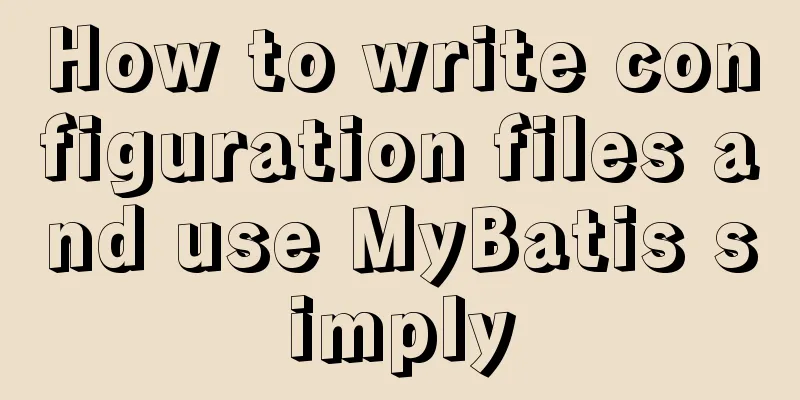Implementation of Node connection to MySQL query transaction processing

|
I have used MySQL many times, and I mainly play with NodeJS. I wrote an article specifically to talk about how to connect
Enter the topic mysql add, delete, modify and queryFirst, we download a dependency package called mysql. This package connects to the database through nodejs code to operate the database. Create a folder and quickly generate the D:\nodejs_mysql>npm init -y # Quickly create package management files Install Dependencies D:\nodejs_mysql>npm i mysql -D # Install mysql dependency package Create an
const mysql = require("mysql");
// Create a mysql connection pool const pool = mysql.createPool({
host: "127.0.0.1", // The address 127.0.0.1 for connecting to the database is the local mysql
user: "root", // Username for connecting to the database root has the highest authority password: "", // Password for connecting to the database database: "apm", // Database name for operation port: "3306", // Port number for connecting to MySQL multipleStatements: true, // This item can be ignored if you want to execute multiple SQL statements at once });
function select() {
// Request to connect to mysql
pool.getConnection((err, connection) => {
// Report an error if the connection is not successful if (err) throw err;
// Get a connection object and call the query method to execute the SQL statement let sql = "select * from goods";
// Run the SQL statement query The second parameter is the parameter required by the SQL statement, you can leave it blank connection.query(sql, (errors, results, fields) => {
// Release the connection connection.release();
// If there is an error when running the sql statement, throw an error if (errors) throw errors;
console.log(results);
console.log(fields);
});
});
}
select(); The above code queries the data of a data table Encapsulation method uses
// index.js
// ... Ignore the previous code to create a MySQL connection pool function query(sql, params) {
return new Promise((resolve, reject) => {
pool.getConnection((err, connection) => {
// Report an error if the connection is not successful if (err) return reject(err);
// Get a connection object and call the query method to execute the SQL statement // Run the SQL statement query The second parameter is the parameter required by the SQL statement, which can be omitted connection.query(sql, params, (errors, results, fields) => {
// Release the connection connection.release();
// If there is an error in running the sql statement, throw an error if (errors) return reject(errors);
resolve(results);
});
});
});
}
query("select * from goods", null).then((result) => {
console.log(result);
});
module.exports = {
query,
};use
// data.js
const index = require("./index.js");
var sql = "select * from goods";
index
.query(sql, null)
.then((result) => {
// do anything ....
})
.catch((err) => {
// error
console.log(err);
}); This exposes an interface for the database to run SQL. Use MySQL transaction processingWhen it comes to MySQL transactions, I will not go into too much detail. Here is a link for your convenience. MySQL Transaction Processing Let's get straight to the point and use
// index.js
// .... Part of the code to create a pool /**
* mysql transaction processing * @param {Array} sqls sql statement to be executed * @param {Array} params corresponding to the parameters of the above sql statement * @returns {Promise} returns a Promise
*/
function transaction(sqls, params) {
return new Promise((resolve, reject) => {
pool.getConnection(function (err, connection) {
// Connection failed promise returns failure directly if (err) {
return reject(err);
}
// If the statement and parameter number do not match, promise returns failure directly if (sqls.length !== params.length) {
connection.release(); // Release return reject(new Error("The statement does not match the passed value"));
}
// Start executing transaction connection.beginTransaction((beginErr) => {
// Failed to create transaction if (beginErr) {
connection.release();
return reject(beginErr);
}
console.log("Start executing transactions, a total of " + sqls.length + " statements");
// Return a promise array let funcAry = sqls.map((sql, index) => {
return new Promise((sqlResolve, sqlReject) => {
const data = params[index];
connection.query(sql, data, (sqlErr, result) => {
if (sqlErr) {
return sqlResolve(sqlErr);
}
sqlReject(result);
});
});
});
// Use the all method to check the status of each promise in it Promise.all(funcAry)
.then((arrResult) => {
// If each sql statement is executed successfully, it will come to this point. Here, the transaction needs to be committed, and the previous sql execution will take effect. // Commit the transaction connection.commit(function (commitErr, info) {
if (commitErr) {
// Transaction submission failed console.log("Transaction submission failed: " + commitErr);
// Transaction rollback, previously executed SQL statements are invalid connection.rollback(function (err) {
if (err) console.log("Rollback failed: " + err);
connection.release();
});
// Return promise failure status return reject(commitErr);
}
connection.release();
// The transaction successfully returns the result of each sql execution as an array structure resolve(arrResult);
});
})
.catch((error) => {
// If one of the multiple SQL statements reports an error during execution, rollback directly connection.rollback(function () {
console.log("sql execution failed: " + error);
connection.release();
reject(error);
});
});
});
});
});
}
module.exports = {
transaction,
};After that, you only need to call this method to execute the mysql transaction
// data.js
const index = require("./index.js");
var sqls = [
"delete from goods where goods_id = ?", // delete statement "update goods set num = ? where goods_id = ?;", // update statement];
var params = [
[1], // parmas is in array format and corresponds to the sql statement in sqls? [5, 3],
];
index
.transaction(sqls, params)
.then((arrResult) => {
// do anything ....
})
.catch((err) => {
// error
console.log(err);
});This is the end of this article about the implementation of node connection mysql query transaction processing. For more relevant node connection mysql query transaction processing content, please search 123WORDPRESS.COM's previous articles or continue to browse the following related articles. I hope everyone will support 123WORDPRESS.COM in the future! You may also be interested in:
|
<<: Discussion on the browsing design method of web page content
>>: Detailed explanation of MySQL database isolation level and MVCC
Recommend
jQuery achieves breathing carousel effect
This article shares the specific code of jQuery t...
When you enter a URL, what exactly happens in the background?
As a software developer, you must have a complete...
Share the problem of Ubuntu 19 not being able to install docker source
According to major websites and personal habits, ...
How to use CURRENT_TIMESTAMP in MySQL
Table of contents Use of CURRENT_TIMESTAMP timest...
Webpack file packaging error exception
Before webpack packaging, we must ensure that the...
A brief discussion on the maximum number of open files for MySQL system users
What you learn from books is always shallow, and ...
How to install multiple mysql5.7.19 (tar.gz) files under Linux
For the beginner's first installation of MySQ...
Detailed explanation and extension of ref and reactive in Vue3
Table of contents 1. Ref and reactive 1. reactive...
Some common advanced SQL statements in MySQL
MySQL Advanced SQL Statements use kgc; create tab...
Detailed installation process of Jenkins on Linux
Table of contents 1. Install JDK 2. Install Jenki...
Use of provide and inject in Vue3
1. Explanation of provide and inject Provide and ...
Introduction to generating Kubernetes certificates using OpenSSL
Kubernetes supports three types of authentication...
UTF-8 and GB2312 web encoding
Recently, many students have asked me about web p...
An article to deal with Mysql date and time functions
Table of contents Preface 1. Get the current time...
Simple usage of MySQL temporary tables
MySQL temporary tables are very useful when we ne...










